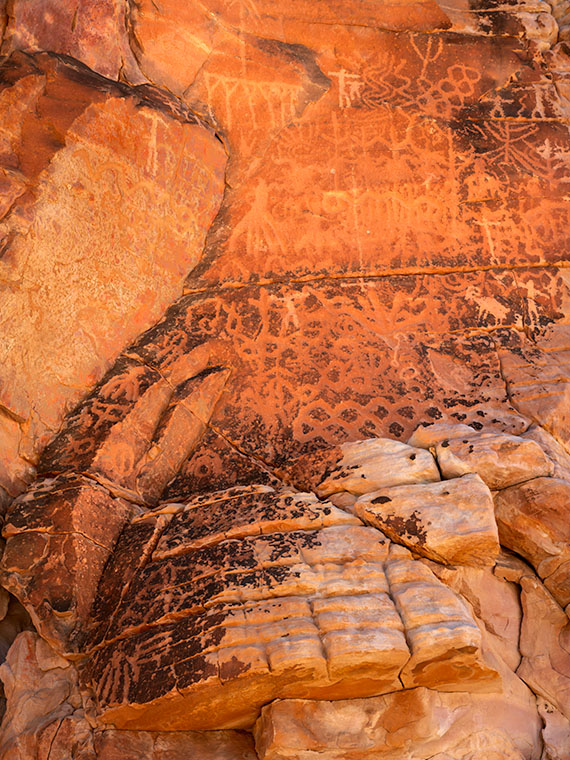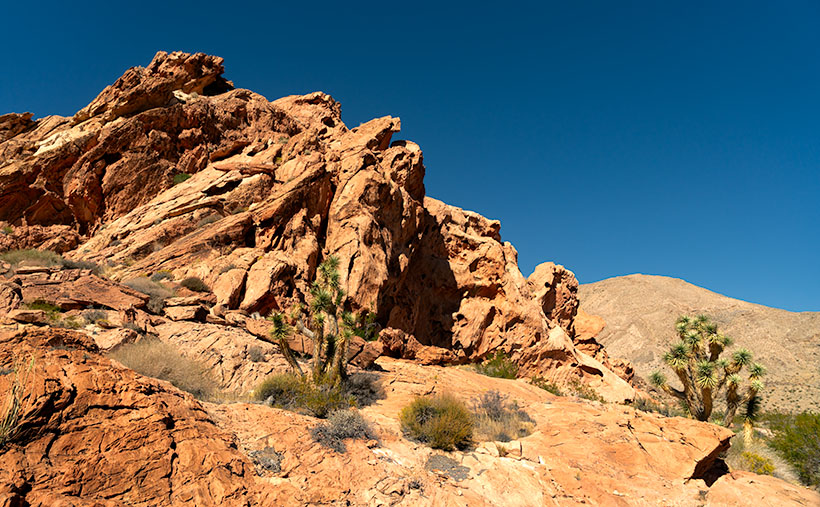
When we left last week’s adventure, I had found my way back to the main trail. So, with the panic behind us for the moment, I could bide my time and closely examine the surrounding formations for exciting shots. Lest we forget, I was in the process of hunting down the ‘easy to find’ Petroglyphs.
With each step, the downhill trail heading toward Lake Mead took me back hundreds of thousands of years in geologic time. As shown in last week’s photos, we journeyed from the white Navajo Sandstone era to its contact with the iron-rich red Entrada Sandstone – another silica formation having more iron-oxide (rust) content.
As the trail continued, I was surrounded by red sandstone outcrops covered in the same streaked varnish pervasive in the Lake Powell area. This was a good sign because the black streaking was a common medium for Pueblo Tribes to carve images into. I had been focusing my search at eye level because that’s the height I expected to see the wall art. But, after rounding a bend, I had to step back because I finally found my prize.
There I was, neck craned, eyes skyward, when I finally spotted the petroglyphs. I half expected a Fremont elevator to whoosh down and offer me a ride up for a closer look. Alas, no such luck—I had to settle for the zoom on my camera. With one mystery solved, another popped up. How in the world did these people scratch those images into the rock? Did they build scaffolds, dangle from ropes, or stand on each other’s shoulders? Maybe they were aliens and had invented the anti-gravity hover-walker I longed for. Who knows?
The Fremont and Ancestral Puebloan (often known as Anasazi) Peoples were two distinct cultures that flourished in the American Southwest, leaving behind a rich legacy of rock art that continues to intrigue us today.
The Fremont People, inhabiting parts of modern-day Utah, Colorado, Idaho, and Nevada from roughly 300 to 1300 AD, are noted for their distinctive rock art. Fremont petroglyphs often depict trapezoidal human figures adorned with elaborate decorations, such as headdresses, earrings, and necklaces. These figures are sometimes accompanied by animals, hunting scenes, and abstract symbols. Their rock art, etched in cliff walls and boulders, speaks to a culture deeply connected to its natural environment and spiritual beliefs.
In contrast, the Ancestral Puebloans (Anasazi), primarily located in the Four Corners region (where Utah, Colorado, Arizona, and New Mexico meet), thrived from approximately the 12th century BCE to the 16th century AD. Their petroglyphs and pictographs differ from those of the Fremont. Ancestral Puebloan art frequently features geometric shapes, spirals, bighorn sheep, and handprints with a more abstract quality. Their artwork often reflects cosmological concepts, clan symbols, and records of celestial events.
Both cultures’ art provides valuable insights into their lives, beliefs, and interactions with the landscape. At the same time, Fremont’s art tends to be more symbolic and detailed in depicting figures; the Ancestral Puebloans lean towards the figurative and abstract. These differences highlight the diversity of expression in ancient rock art and illustrate the unique ways each culture related to its surroundings and spiritual life.
The struggle in photographing relics of ancient civilizations is finding them—and finding them undamaged. When you’re standing in front of them, the best that you can do is to frame them in a logical composition. What do you include or leave out of the frame? At this point, creativity goes out the window, and you become a record keeper; your work is indistinguishable from that of a geologist or archaeologist. That’s the mental process that I had when I snapped Cliffside Chronicles. As I aimed the camera, it was thinking, “Hold the camera straight, get as much artwork in as possible, and frame the image tight.” The rock art is impressive enough, and I don’t presume to think I can improve the artists’ work. These shots are my way of collecting these precious works of art and preserving a record of their existence should they be destroyed by vandals.

I hope you enjoyed our hike out to the petroglyphs. If your curiosity has bettered you, there are always larger versions of Cliffside Chronicles for you to examine on my website < Jim’s Website> and the Fine Art America page <FAA Link>. We encourage you to return next week when we look at a geological mystery I found.
Till next time, keep your spirits high and your humor dry.
jw
Techniques: The Magic of Polarizing Filters
Sometime in the last century, when I was a lad still wet behind the ears (what does that actually mean?), I bought a polarizing filter for my first camera. I was less than impressed when I used it in the Los Angeles suburbs. It didn’t seem to do much in the smoggy, hazy atmosphere along the coast. But on a trip to Lake Mead—where my dad kept his boat—boy, howdy, that thing did miracles. That’s the exact general location that we’re featuring in this month’s project, and there is something about the glare of the Mohave Desert that makes one of these filters a must in your camera bag.
A polarizing filter is essential in the bright landscape of Gold Butte, where the white Navajo sandstone reflects the sun’s glare. This tool helps mitigate the glare, allowing the camera to capture the vivid hues and intricate details often masked by the harsh light. By filtering polarized light, the polarizer enhances the natural color saturation of the rocks and the sky, bringing out a richness that the naked eye might miss.
Using a polarizing filter requires a bit of finesse, as it’s most effective when the sun is at a 60-degree angle to the lens. It can darken the blue sky to a dramatic effect and increase the contrast between the sky and clouds, giving your images a more dynamic range. However, be mindful of exposure adjustments since a polarizer reduces the light entering your lens, often necessitating a slower shutter speed or wider aperture. With practice, a polarizing filter will cut through glare and transform your landscapes into deeply textured, color-rich images.
Don’t let the desert’s glare wash out the nuances of its beauty; make sure a quality polarizing filter is part of your photography kit. Remember, like any lens, the quality of a polarizer matters – a cheap one may distort your image and alter true colors. However, consider that polarizers absorb light; they’re fantastic under the brilliant sun but can leave your photos underexposed in dimmer conditions. A polarizing filter in low light is like sunglasses at midnight – you will miss the stars and probably trip over the campfire. It is best to keep it tucked away when the sun takes its siesta.

Jim, If you lived in the South Puget Sound area like me, you’d almost never need such a filter. It doesn’t rain as much as most folks think, but we do have a lot of overcast days. Actually, that makes for quite beautiful bird pics, etc. because the colors seem to be more naturally bright & vibrant.
You’re right, Gary. Polarizers effectiveness on foggy or overcast days is minimal. But, here in the desert, where the weather is the inverse of yours, they can change an image dramatically. I even were polarizing sunglasses for driving, and people look at me weird when I tilt my head from side to side. It’s like rotating the lens, but people think I’m ringing my bell. – jw
So glad you found the petroglyphs. Seems like there are layers. Writing over time. Certainly more than one artist. The height is interesting and does make you wonder how they got them so high???Maybe they used stilts😁. The colors in the rock are wonderful. Hike must have been gorgeous.
I agree with you, Deb. I read somewhere that panels like this with repetitive designs indicating that a clan passed by, and the count indicates how many times they stopped. I only wonder how they found their way back each year. – jw